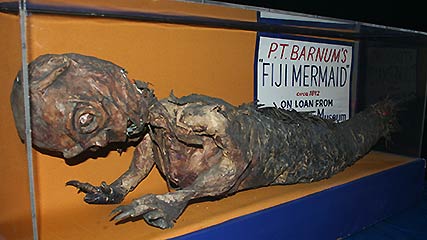I will never forget being eight years old, on a long road trip across the desert from Texas to Arizona, seeing billboard signs for “The Thing?”
After every mile passed, the signs became more frequent – we were 100 miles away, then 75 and then 50. With each billboard, my curiosity grew; so too did the pleas to my parents for us to make a detour and see this thing that was obviously not to be missed. Finally, they relented and we exited off the highway. As we approached the obvious tourist trap, there were even more signs telling us how much this excursion would cost and where we needed to deposit our money before entering to see The Thing.
I remember hiding behind my mother and holding my father’s hand while we followed yellow painted footprints, looking at random old crap like animal skeletons and old vehicles. Being eight, museums did not hold my interest. The only thing on my mind was to see what The Thing could possibly be. This mystery had to be answered. The suspense was killing me. And then, there it was, looming before us in a concrete coffin. The Thing was a mummified corpse. I recoiled in both horror and disappointment. I had been hoping to see Bigfoot or a Chupacabra, or heck, even a jackalope – some mythical creature that had been found and transported into this desert mirage. This is how I imagine Phineas Taylor Barnum’s public felt when he hoaxed them time and time again.
“There’s a customer born every minute,” is a phrase that is often attributed to P.T. Barnum. Although he is often thought of for being a circus man, that came much later in his life. Using larger-than-life advertisements such as giant flags, paintings of animals in windows, and a lighthouse light, Barnum made his museum into a success. He would showcase freaks and oddities from albino, midgets and conjoined twins, to giants, magicians and exotic animals. Barnum weathered accusations of fraud with the attitude that there was no such thing as bad press. He was a promoter of dubious attractions.
He was a master of advertisement, blanketing newspapers with advertisements for the man-made freak, the FeeJee Mermaid (a creature with the head of a monkey and the tail of a fish). Just as I had prepared myself for what I would find when I eventually saw the Thing, visitors envisioned a beautiful mermaid in their heads and were sorely disappointed. He also introduced the 5-year-old midget, Tom Thumb – who he taught to smoke cigars and drink – to draw crowds into his museum.
In 1835, he paid $1,000 to buy a slave woman, Joice Heth, who had claimed to be George Washington’s nurse – making her 161-years-old. Near the end of her life, she was blind and practically paralyzed. Barnum took her on a 7-month tour, where Heth told stories about George Washington as a child. Her age was discussed at length in the press, and Barnum claimed he would allow for an autopsy to be performed proving her actual age. She died a year later, and it was proven that she was really only about 80-years-old. At first, Barnum claimed the actual person who had been autopsied was a fraud, but later admitted the truth to his hoax.
People knew his reputation as being a man who would often play tricks on them, but they would still shower him with money as they went to see his oddities, hoping to find the creatures made famous by myths and stories. I know the disappointment they must have felt, but I still remember the anticipation and the joy of just getting there and finally seeing for myself what that Thing truly was.









Leave a response